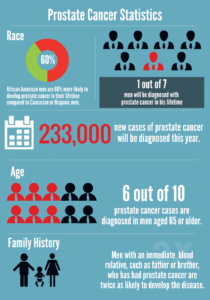Prostate cancer is the most common non-skin cancer in America, affecting 1 in 7 men. Approximately 233,000 men will be diagnosed with prostate cancer in 2014, and more than 29,000 men will die from the disease. One new case occurs every 2.3 minutes and a man dies from prostate cancer every 18 minutes. A non-smoking man is more likely to develop prostate cancer than he is to develop colon, bladder, melanoma, lymphoma and kidney cancers combined. In fact, the latest statics reveal that a man is 35% more likely to be diagnosed with prostate cancer than a woman is to be diagnosed with breast cancer.
As serious as prostate cancer can be, most men diagnosed with it do not die from it. In fact, more than 2.5 million men in the United States who have been
diagnosed with prostate cancer at some point are still alive today.
Race, age and family history all affect the likelihood of a man being diagnosed with the disease.
African American men are 60% more likely to develop prostate cancer compared with Caucasian and Hispanic men and nearly 2.5 times more likely to die from the disease.
As men increase in age, their risk of developing prostate cancer exponentially increases. Although only 1 in 10,000 under age 40 will be diagnosed, the rate increases to 6 in 10 for ages 65 and older.
Men with a single first-degree relative—father, brother, or son—with a history of prostate cancer are twice as likely to develop the disease, while those with two or more relatives are nearly four times as likely to be
diagnosed.
Because nearly 90% of all prostate cancer is detected in the local and regional stages, the cure rate for prostate cancer is very high—nearly 100% of men diagnosed at this stage will be disease-free after five years. This is largely due to advancements in healthcare. By contrast, in the 1970s, only 67% of men diagnosed with local or regional prostate cancer were disease-free after five years.
In the earliest stages, most men with prostate cancer will not experience any symptoms. Some men, however, will experience frequent, hesitant, or burning urination, difficulty in having an erection, or pain or stiffness in the lower back, hips or upper thighs.
Because these symptoms can also indicate the presence of other diseases or disorders, we do a thorough “work-up” of each patient to determine the underlying cause of the symptoms.
We screen for prostate cancer by doing a prostatespecific antigen blood test (PSA) and a digital rectal exam (DRE – often referred to as a “prostate exam”).
If there are any abnormal findings, a biopsy will be recommended to make a definitive diagnosis. Prostate cancer treatments vary from one individual to another. Once a patient is diagnosed, his treatment can be tailored to his specific needs.



